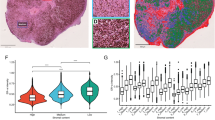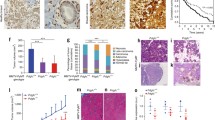Abstract
Prolactin (PRL) promotes the proliferation and survival of breast cancer cells in part via the transactivation of human epidermal growth factor receptor 2 (HER2), also known as Neu in rodents. A PRL receptor (PRLR) antagonist, G129R, has been developed, which indirectly inhibits the tyrosine phosphorylation of HER2 (p-HER2) in human breast cancer cell lines. In this study, we investigate the effects of cancer-associated fibroblasts (CAFs) upon this molecular cross-talk using tumor cells and CAFs derived from spontaneous mammary tumors of female MMTV-neu transgenic mice. Tumors were resected and cultured as small tumor chunks (~3 mm3) or were cultured in monolayer. G129R reduced tyrosine phosphorylation of Neu (p-Neu) in a dose-dependent manner (IC50 ~10 μg/ml) in tumor chunks, but had no effect on primary tumor epithelial cells grown in monolayer. Direct co-culture of mouse or human tumor epithelial cell lines with CAFs restored the epithelial cells’ response to G129R, similar to that observed in mouse tumor chunks. The addition of PRL, as expected, induced p-Neu in both the tumor chunk and co-culture models. The inhibitory effect of G129R was absent when CAFs were physically separated from mouse tumor epithelial cells using a transwell system, or when CAFs were replaced with normal fibroblasts in direct co-culture with human or mouse tumor epithelial cells. In vivo, G129R reduced p-Neu levels in primary mammary tumors of mice in a time- and dose-dependent manner. In conclusion, CAFs play a critical role in bridging the cross-talk between PRL and HER2/Neu in both mouse and human models of breast cancer. The inhibitory effects of G129R on p-Neu and on tumor growth are dependent upon interactions of tumor epithelial cells with CAFs.







Similar content being viewed by others
References
LaPensee EW, Ben-Jonathan N (2010) Novel roles of prolactin and estrogens in breast cancer: resistance to chemotherapy. Endocr Relat Cancer 17(2):R91–R107
Schroeder MD, Symowicz J, Schuler LA (2002) PRL modulates cell cycle regulators in mammary tumor epithelial cells. Mol Endocrinol 16(1):45–57
Liby K et al (2003) Prolactin overexpression by MDA-MB-435 human breast cancer cells accelerates tumor growth. Breast Cancer Res Treat 79(2):241–252
Tao J et al (2011) PAK1-Nck regulates cyclin D1 promoter activity in response to prolactin. Mol Endocrinol 25(9):1565–1578
Goldhar AS et al (2005) Prolactin-induced expression of vascular endothelial growth factor via Egr-1. Mol Cell Endocrinol 232(1–2):9–19
Maus MV, Reilly SC, Clevenger CV (1999) Prolactin as a chemoattractant for human breast carcinoma. Endocrinology 140(11):5447–5450
Clevenger CV et al (2003) The role of prolactin in mammary carcinoma. Endocr Rev 24(1):1–27
Furth PA et al (2011) Signal transducer and activator of transcription 5 as a key signaling pathway in normal mammary gland developmental biology and breast cancer. Breast Cancer Res 13(5):220
Sakamoto K et al (2010) Janus kinase 2 is required for the initiation but not maintenance of prolactin-induced mammary cancer. Oncogene 29(39):5359–5369
Sultan AS, Brim H, Sherif ZA (2008) Co-overexpression of Janus kinase 2 and signal transducer and activator of transcription 5a promotes differentiation of mammary cancer cells through reversal of epithelial-mesenchymal transition. Cancer Sci 99(2):272–279
Clevenger CV, Torigoe T, Reed JC (1994) Prolactin induces rapid phosphorylation and activation of prolactin receptor-associated RAF-1 kinase in a T-cell line. J Biol Chem 269(8):5559–5565
Das R, Vonderhaar BK (1996) Involvement of SHC, GRB2, SOS and RAS in prolactin signal transduction in mammary epithelial cells. Oncogene 13(6):1139–1145
Aksamitiene E et al (2011) Prolactin-stimulated activation of ERK1/2 mitogen-activated protein kinases is controlled by PI3-kinase/Rac/PAK signaling pathway in breast cancer cells. Cell Signal 23(11):1794–1805
Reynolds C et al (1997) Expression of prolactin and its receptor in human breast carcinoma. Endocrinology 138(12):5555–5560
Ginsburg E et al (2010) Characterization of ductal and lobular breast carcinomas using novel prolactin receptor isoform specific antibodies. BMC Cancer 10:678
Galsgaard ED et al (2009) Re-evaluation of the prolactin receptor expression in human breast cancer. J Endocrinol 201(1):115–128
Tworoger SS, Hankinson SE (2006) Prolactin and breast cancer risk. Cancer Lett 243(2):160–169
Tworoger SS, Sluss P, Hankinson SE (2006) Association between plasma prolactin concentrations and risk of breast cancer among predominately premenopausal women. Cancer Res 66(4):2476–2482
Tworoger SS et al (2011) The combined influence of multiple sex and growth hormones on risk of postmenopausal breast cancer: a nested case-control study. Breast Cancer Res 13(5):R99
Emde A., Kostler WJ, and Yarden Y (2010) Therapeutic strategies and mechanisms of tumorigenesis of HER2-overexpressing breast cancer. Crit Rev Oncol Hematol [Epub ahead of print]
Gutierrez C, Schiff R (2011) HER2: biology, detection, and clinical implications. Arch Pathol Lab Med 135(1):55–62
Frasor J, Gibori G (2003) Prolactin regulation of estrogen receptor expression. Trends Endocrinol Metab 14(3):118–123
Sharma D et al (2006) Restoration of tamoxifen sensitivity in estrogen receptor-negative breast cancer cells: tamoxifen-bound reactivated ER recruits distinctive corepressor complexes. Cancer Res 66(12):6370–6378
Frank SJ (2008) Mechanistic aspects of crosstalk between GH and PRL and ErbB receptor family signaling. J Mammary Gland Biol Neoplasia 13(1):119–129
Carver KC, Schuler LA (2008) Prolactin does not require insulin-like growth factor intermediates but synergizes with insulin-like growth factor I in human breast cancer cells. Mol Cancer Res 6(4):634–643
Scotti ML et al (2008) Additive effects of a prolactin receptor antagonist, G129R, and herceptin on inhibition of HER2-overexpressing breast cancer cells. Breast Cancer Res Treat 111(2):241–250
Bhowmick NA, Neilson EG, Moses HL (2004) Stromal fibroblasts in cancer initiation and progression. Nature 432(7015):332–337
Dalton WS (1999) The tumor microenvironment as a determinant of drug response and resistance. Drug Resist Updat 2(5):285–288
Campbell MJ et al (2002) Epithelial and fibroblast cell lines derived from a spontaneous mammary carcinoma in a MMTV/neu transgenic mouse. In Vitro Cell Dev Biol Anim 38(6):326–333
Nagy A (2003) Manipulating the mouse embryo: a laboratory manual, vol.X, 3rd edn. Cold Spring Harbor Laboratory Press, Cold Spring Harbor, p 764
Yamauchi T et al (2000) Constitutive tyrosine phosphorylation of ErbB-2 via Jak2 by autocrine secretion of prolactin in human breast cancer. J Biol Chem 275(43):33937–33944
Slamon DJ et al (1989) Studies of the HER-2/neu proto-oncogene in human breast and ovarian cancer. Science 244(4905):707–712
Vogel CL et al (2002) Efficacy and safety of trastuzumab as a single agent in first-line treatment of HER2-overexpressing metastatic breast cancer. J Clin Oncol 20(3):719–726
Hazlehurst LA, Landowski TH, Dalton WS (2003) Role of the tumor microenvironment in mediating de novo resistance to drugs and physiological mediators of cell death. Oncogene 22(47):7396–7402
Huck L et al (2010) Beta1-integrin is dispensable for the induction of ErbB2 mammary tumors but plays a critical role in the metastatic phase of tumor progression. Proc Natl Acad Sci U S A 107(35):15559–15564
Cirri P, Chiarugi P (2011) Cancer associated fibroblasts: the dark side of the coin. Am J Cancer Res 1(4):482–497
Ayala G et al (2003) Reactive stroma as a predictor of biochemical-free recurrence in prostate cancer. Clin Cancer Res 9(13):4792–4801
Dittmar T et al (2002) Induction of cancer cell migration by epidermal growth factor is initiated by specific phosphorylation of tyrosine 1248 of c-erbB-2 receptor via EGFR. FASEB J 16(13):1823–1825
Ben-Levy R et al (1994) A single autophosphorylation site confers oncogenicity to the Neu/ErbB-2 receptor and enables coupling to the MAP kinase pathway. EMBO J 13(14):3302–3311
Akhtar N, Streuli CH (2006) Rac1 links integrin-mediated adhesion to the control of lactational differentiation in mammary epithelia. J Cell Biol 173(5):781–793
Streuli CH et al (1995) Stat5 as a target for regulation by extracellular matrix. J Biol Chem 270(37):21639–21644
Zoubiane GS et al (2004) A role for the cytoskeleton in prolactin-dependent mammary epithelial cell differentiation. J Cell Sci 117(Pt 2):271–280
Galbaugh T, Feeney YB, Clevenger CV (2010) Prolactin receptor-integrin cross-talk mediated by SIRP alpha in breast cancer cells. Mol Cancer Res 8(10):1413–1424
Guo W et al (2006) Beta 4 integrin amplifies ErbB2 signaling to promote mammary tumorigenesis. Cell 126(3):489–502
Acknowledgments
The authors would like to thank Alison Springs, Jang Pyo Park, and Eric Lee for their contributions to this manuscript. This study was supported in part by the Endowment Fund of the Greenville Hospital System and a grant from Oncolix Inc.
Conflicts of interest
None.
Author information
Authors and Affiliations
Corresponding author
Rights and permissions
About this article
Cite this article
Xu, C., Langenheim, J.F. & Chen, W.Y. Stromal–epithelial interactions modulate cross-talk between prolactin receptor and HER2/Neu in breast cancer. Breast Cancer Res Treat 134, 157–169 (2012). https://doi.org/10.1007/s10549-012-1954-3
Received:
Accepted:
Published:
Issue Date:
DOI: https://doi.org/10.1007/s10549-012-1954-3




